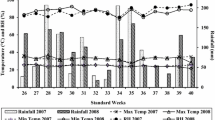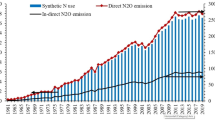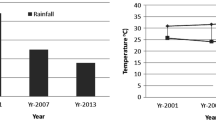Abstract
The possibilities of integrated nutrient management for sustainable ricecultivation are investigated for rainfed, lowland rice in Sukumaland,northwestern Tanzania. Typical, hardpan rice soils in Sukumaland have ratherlowlevels of organic matter, total nitrogen and available phosphorus, and a low tomedium amount of exchangeable potassium. Consumption of mineral fertilizers inrice is, however, very low due to availability problems and sharply increasedprices of fertilizers. Use of locally available resources for soil fertilityimprovement is hampered by the additional inputs of farm household labourinvolved. High labour inputs per hectare without increases in capital inputslead to lower marginal and average products per hour of labour. Furthermore, insemi-arid Sukumaland biomass production of green manures is seriouslyrestrictedby climate. The amount of kraal cattle manure is insufficient and half thehouseholds have no easy access to it. Using rice straw as cattle feed andthatching material has priority over soil fertility improvement. Some farmersindicate that at present there is not yet an urgent need for improvedintegratednutrient management in Sukumaland rice cultivation. Adoption of integratednutrient management based technologies depends on conducive socio-economic,agro-ecological and public policy circumstances. Farmer investment in learningand a favourable policy environment are thus no guarantee for worldwideadoptionof these technologies by farm households.
Similar content being viewed by others
References
Barratt Brown M. 1995. Africa's Choices: After Thirty Years of the World Bank. Penguin Books Ltd., London.
Bhuiyan N.I. and Zaman S.K. 1996. Use of green manuring crops in rice fields for sustainable production in Bangladesh agriculture. In: Rahman M. (ed.), Biological Nitrogen Fixation Associated with Rice Production. Kluwer Academic Publishers, Dordrecht, The Netherlands, pp. 51–64.
Boserup E. 1965. The Conditions of Agricultural Growth: The Economics of Agrarian Change under Population Pressure. Earthscan, London, republished 1993.
Conelly W.T. 1994. Population pressure, labor availability, and agricultural disintensification: the decline of farming on Rusinga Island, Kenya. Human Ecol. 22: 145–170.
Doggett H. 1965. A history of the work of the Mwabagole rice station, Lake Province, Tanzania. E. Afr. Agricult. For. J. 31: 16–20.
Donkers H. 1993. Duurzame vergroting voedselproduktie in Afrika: veel, weinig of geen externe inputs? (Increasing Sustainable Food Production in Africa: many, few or no external inputs?) Derde Wereld 12: 63–85.
Enserink H.J., Bunyecha K.F., Meertens H.C.C., Kajiru G.J. and Bagarama F. 1994. From farming systems research and extension to zonal strategies: rice research in Sukumaland, Tanzania In: Systems-Oriented Research in Agriculture and Rural Development, 13th International Symposium, 21–25 November 1994. CIRAD, Montpellier, France pp. 86–91.
Enyong L.A., Debrah S.K. and Bationo A. 1999. Farmers' perceptions and attitudes towards introduced soil-fertility enhancing technologies in western Africa. Nutrient Cycling Agroecosyst. 53: 177–187.
FAO 1997. Project Findings and Recommendations. FAO, Rome, AG:GCPF/URT/106/NET Phase III.
Garrity D.P. and Flinn J.C. 1988. Farm-level management systems for green manure crops in Asian rice environments. In: Green Manure in Rice Farming. IRRI, Manila, pp. 111–129.
Geertz C. 1968. Agricultural Involution. The process of Ecological Change in Indonesia, Third Printing. University of California Press, Berkeley, Los Angeles, California.
Greenland D.J. 1997. The Sustainability of Rice Farming. CAB International, Wallingford, UK.
Hyden G., Kates R.W. and Turner II B.L. 1993. Beyond Intensification. In: Turner II B.L., Hyden G. and Kates R.W. (eds), Population Growth and Agricultural Change in Africa. University Press of Florida, Gainesville, Florida, pp. 401–439.
Kieft H. 1992. The future of LEISA in Sub-Saharan Africa. In: Blokland A. and van der Staaij F. (eds), Sustainable Development in Semi-Arid Sub-Saharan Africa. Poverty and Development 4, Ministry of Foreign Affairs, The Hague, The Nethelands, pp. 37–44.
Kundu D.K. and Ladha J.K. 1999. Sustaining productivity of lowland rice soils: issues and options related to N availability. Nutrient Cycling Agroecosyst. 53: 19–33.
Lagemann J. 1977. Traditional African Farming Systems in Eastern Nigeria, An Analysis of Reaction to Increasing PopulationPressure. Weltforum, Munchen, Afrika-Studien 98.
Ludwig H.-D. 1968. Permanent farming on Ukara. The impact of land shortage on husbandry practices. In: Ruthenberg H. (ed.), Smallholder Farming and Smallholder Development in Tanzania. Weltforum, Munchen Afrika-Studien 24, pp. 87–135.
Lupeja P.M. and Meertens H.C.C. 1996. Preliminary results of the 1995/96 cotton FYM-NP trial in Kwimba District, Mwanza Region. Kilimo/FAO Plant Nutrition Programme, URT/FAO, Dar es Salaam.
Makoye J.J. and Winge N.J. 1996. Field activities in Shinyanga Region 1994/95. Kilimo/FAO Plant Nutrition Programme, URT/FAO, Dar es Salaam.
Meertens H.C.C. and Ndege L.J. 1993. The rice cropping system in Sengerema Division, Maswa District. Field Note 37. FSR Project Lake Zone, Ukiriguru/Amsterdam.
Meertens H.C.C. and Lupeja P.M. 1996. A Collection of Agricultural Background Information for Mwanza Region. Kilimo/FAO Plant Nutrition Programme, URT/FAO, Dar es Salaam.
Meertens H.C.C., Ndege L.J. and Enserink H.J. 1992. Results of the urea test in farmer's rice fields; Maswa District. Field Note 26. FSR Project Lake Zone, Ukiriguru/Amsterdam.
Meertens H.C.C., Fresco L.O. and Stoop W.A. 1996. Farming systems dynamics: Impact of increasing population density and the availability of land resources on changes in agricultural systems. The case of Sukumaland, Tanzania. Agricult. Ecosyst. Environ. 56: 203–215.
Meertens H.C.C., Ndege L.J. and Lupeja P.M. 1999. The cultivation of rainfed, lowland rice in Sukumaland, Tanzania. Agricult. Ecosyst. Environ. 76: 31–45.
Milne G. 1947. A soil reconnaissance journey through parts of Tanganyika Territory, December 1935 to February 1936. J. Ecol. 35: 192–265.
Mohanty S.K., Singh U., Balasubramanian V. and Jha K.P. 1999. Nitrogen deep-placement technologies for productivity, profitability, and environmental quality of rainfed lowland rice systems. Nutrient Cycling Agroecosyst. 53: 43–57.
Mulleriyawa R. and Wettasinha C. 1997. Soil fertility management in irrigated rice fields. Ileia. Newslett. 13: 18–19.
Mutert E.W. 1995. Plant nutrient balances in the Asian and Pacific Region: the consequences for agricultural production. Food & Fertilizer Technology Center, Taipei City, Extension bulletin 415.
Nair P.K.R. 1988. Use of perennial legumes in Asian farming systems. In: Green Manure in Rice Farming. IRRI, Manila, pp. 301–317.
Netting R.Mc.C., Stone G.D. and Stone M.P. 1993. Agricultural expansion, intensification, and market participation among the Kofyar, Jos Plateau, Nigeria. In: Turner II B.L., Hyden G. and Kates R.W. (eds), Population Growth and Agricultural Change in Africa. University Press of Florida, Gainesville, Florida, pp. 206–249.
Otsyina R., Asenga D. and Mumba M. 1994. Annual Progress Report 1994. Tanzania/ICRAF Agroforestry Research Project Shinyanga, Shinyanga.
Otsyina R., Asenga D. and Mumba M. 1995. Annual Progress Report 1995. Tanzania/ICRAF Agroforestry Research Project Shinyanga, Shinyanga.
Pingali P., Bigot Y. and Binswanger H.P. 1987. Agricultural Mechanization and the Evolution of Farming Systems in Sub-Saharan Africa,. The Johns Hopkins University Press, Baltimore, Maryland.
Pretty J.N. 1995. Regenerating Agriculture. Policies and Practice for Sustainability and Self-Reliance. Earthscan Publications Ltd, London.
Ravnborg H.M. 1990. Intensification and Differentiation in Agricultural and Livestock Production, Usagara Division, Tanzania. Farming Systems Analysis Paper 10. ICRA, Wageningen, The Netherlands.
Rinaudo G., Alazard D. and Moudiongui A. 1988. Stem-nodulating legumes as green manure for rice in West Africa. In: Green Manure in Rice Farming. IRRI, Manila, pp. 97–109.
Roger P.A. 1995. Biological N2-fixation and its management in 2 wetland rice cultivation. Fert. Res. 42: 261–276.
Rounce N.V. 1949. The agriculture of the cultivation steppe of the Lake,Western and Central Provinces. Longmans, Green and Co., Cape Town.
Rounce N.V. and Thornton D. 1945. Ukara island and the agricultural practices of the Wakara, Nairobi: Revision of Tanganyika Notes and Records, March 1936, Colony and Protectorate of Kenya.
Shapiro B.I. and Sanders J.H. 1998. Fertilizer use in semiarid West Africa: profitability and supporting policy. Agricult. Syst. 56: 467–482.
Smaling E.M.A., Fresco L.O. and de Jager A. 1996. Classifying, monitoring and improving soil nutrient stocks and flows in African agriculture. Ambio 25: 492–496.
Stoorvogel J.J. and Smaling E.M.A. 1990. Assessment of soil nutrient depletion in sub-Saharan Africa, 1983–2000. Report 28, Volume I, Winand Staring Centre, Wageningen, The Netherlands.
Upton M. 1996. The Economics of Tropical Farming Systems. Cambridge University Press, Cambridge, UK.
World Bank 1994. Tanzania Agriculture: A Joint Study by the Government of Tanzania and the World Bank. A World Bank Country Study, World Bank, Washington, DC.
Author information
Authors and Affiliations
Rights and permissions
About this article
Cite this article
Meertens, H. The prospects for integrated nutrient management for sustainable rainfed lowland rice production in Sukumaland, Tanzania. Nutrient Cycling in Agroecosystems 65, 163–171 (2003). https://doi.org/10.1023/A:1022103913683
Issue Date:
DOI: https://doi.org/10.1023/A:1022103913683




